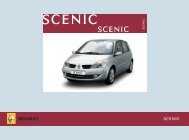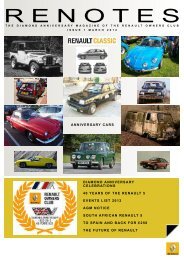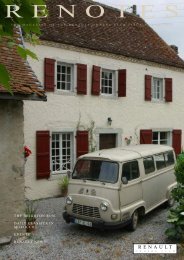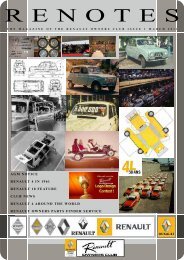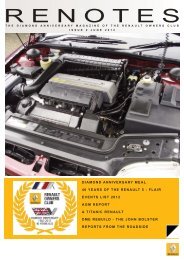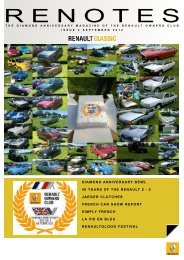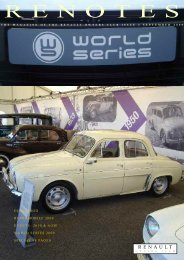March 2010 Renotes Low Quality.pdf - Renault Owners Club Forum
March 2010 Renotes Low Quality.pdf - Renault Owners Club Forum
March 2010 Renotes Low Quality.pdf - Renault Owners Club Forum
Create successful ePaper yourself
Turn your PDF publications into a flip-book with our unique Google optimized e-Paper software.
o b i t u A ryobituAryOwing to press deadlines and theavailability of space inRENOTES, it is with profoundregret that we come so late toreport the passing of yet another inventiveFrenchman, whose career left an indeliblemark on his native motorsport scene of the60s and 70s. On 16 August 2009, JacquesDurand passed away in his 89th year at hishome in Mougins (near Cannes).He was not as well known to the generalpublic as Jean Rédélé or Amédée Gordini,but he was admired by informed Frenchcar enthusiasts for his ability to constructindividual sporting vehicles in an erabefore meddlesome bureaucracyinterfered and made such individualitylegally impossible. The judiciousamalgam of car manufacturers’components minimised the cost of hisvehicles, a range of ‘etceterini,’ whichoffered diverting performance toenthusiasts. This life was lived somewhatin the shadows (especially as far asanglophone enthusiasts are concerned)and so we make no apology for a lengthyoutline of Jacques Durand’s life, whichwill allow RENOTES readers toappreciate better the merits of theunheralded life of a very individualFrenchman.Jacques’ grandparents had a flower shopin Paris; his father was a senior officer inthe Postes à Arts et Métiers in the capitaland he had a weekend retreat built atAntony, then in the country, but now aParisian dormitory suburb. Born on 28June 1920, Jacques grew up there andwent to the Lakanal lycée in nearbyScéaux. His parents hoped that he wouldbecome a government official, but the boywas determined to work with his hands,so he changed career direction and wentto the École des Ateliers des PTT (thePost Office training centre) at Gentilly.Having finished his training during WW2,he was evacuated to Limoges (in centralFrance). Which he reached by pedalcycle!. A few months later, he returned toParis and, acting on a friend’s tip-off, hetook action to evade the STO (‘service detravail obigatoire’, a conscription serviceintroduced by the German occupyingforces in France).He went to ground in the Parisian suburbsand started to manufacture minihorsepower engines under the name ofJIDÉ. These propulsion units for modelaeroplanes, cars and boats became leadersin their field, and they were sold throughPaillard’s Bookshop in Besançon. In1949, he dropped the JIDÉ range andstarted the VEGA range, which name alsocovered a new venture, the manufactureof light alloy model cars (sorry, no<strong>Renault</strong>s), which raced around specialVCC (‘vol circulaire contrôlé’) tracks. Hebecame a friend of Adrien Maeght, thewell-known Parisian retailer of modelsand of premier quality reproductions ofmodern paintings, later founding editor of‘L’Automobiliste’ magazine and,eventually, founder of the (regrettablyrecently closed) Musée Automobile deMougins, which housed a large exhibitionof VEGA artefacts.Following a visit to the garage of M.Vinatier (the father of the well-knownAlpine and <strong>Renault</strong> driver, Jean), wherehe saw an Alpine, Jacques realised that hecould build a similar car of his owndesign, with the coachwork made out ofplastic and so he taught himself how towork with polyester resin and glassfibrereinforcings. In 1958, he constructed hisfirst car in the basement of the house atAntony, in which he was assisted by aneighbour, Charles Cusson (on thechassis), who later developed the FormulaFrance ARPA single-seater, and also by anengineer, Henri Madalana, and byFrançois Marcarian, who later moved onto work firstly for Colin Montrouge (aleading Parisian <strong>Renault</strong> dealer and CoupeGordini supporter) and then for himself asa fibreglass subcontractor to <strong>Renault</strong>sport(F1 and 5 Turbo & Maxi) and to SnobeckRacing.Based on a multi tubular steel frame, theAtla had gull-wing doors and used aselection of major <strong>Renault</strong> 4CVcomponents, although, for a Montrougegarage owner, M. Caron, a single (yellow)example was custom-built to accept thePanhard Dyna Z flat-twin fwd engine andtransmission bloc up front. Totalproduction is believed to be 12, of whichthree (possibly four) examples havesurvived. Day-to-day finance wasprovided on a rather erratic basis by acertain Jean Schwab, a <strong>Renault</strong> agent atGarches, who was developing a petroleconomiser at the time, and it was he,who, having seen the original Atla,‘seconded’ his own employee, RobertJonet, to Antony, in order to assist Jacqueswith the painting and trimming of theproduction cars.10 r e N o t e s M A G A Z i N eR E N O T E S M A G A Z I N E



